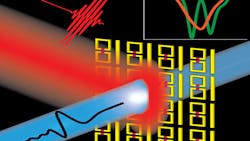Artificially created composite materials, also known as metamaterials, promise behavior beyond what is normally found in nature, such as dielectric materials with negative permeability and permittivity. In search of potential circuit applications for metamaterials, researchers from Australia’s Queensland University of Technology and Malaysia’s Universiti Kebangsaan Malaysia investigated the use of microstrip transmission lines and dual-star, split-ring resonators (DSSRRs) fabricated on metamaterials to achieve circuit sizes much smaller than normally dictated by quarter- and half-wavelength structures. They explored left-handed (LH) and right-handed (RH) metamaterial media to better understand some potential capabilities of metamaterials for RF and microwave circuits.
The researchers designed a DSSRR with metallic rings on top of a metamaterial substrate. Two opposite rings were formed, with a small gap to obtain a negative resonance. The bandwidth of the resonator can be enhanced by gap tuning. A DSSRR is fabricated in microstrip technology by etching the rings just below the surface of the substrate. The performance of this periodic unit-cell resonator was measured by vector network analysis and S-parameters. The first resonance was detected at 8.9 GHz, and the second–at about 16 dB less in amplitude—at 10 GHz. The same period unit-cell DSSRR was fabricated on commercial circuit material with dielectric constant of 10.2, RT6010 laminate from Rogers Corp., so as to verify the basic performance of the resonator.
The experimenters closely matched their numerical predictions with measured results as part of a study to better understand the properties of composite right-handed/left-handed (CRLH) metamaterials as microwave substrates. It confirmed a great deal of metamaterial theory as applied to RF/microwave circuits.
See “Making Meta Better,” IEEE Microwave Magazine, Vol. 17, No. 8, August 2016, p. 52.
About the Author
Jack Browne
Technical Contributor
Jack Browne, Technical Contributor, has worked in technical publishing for over 30 years. He managed the content and production of three technical journals while at the American Institute of Physics, including Medical Physics and the Journal of Vacuum Science & Technology. He has been a Publisher and Editor for Penton Media, started the firm’s Wireless Symposium & Exhibition trade show in 1993, and currently serves as Technical Contributor for that company's Microwaves & RF magazine. Browne, who holds a BS in Mathematics from City College of New York and BA degrees in English and Philosophy from Fordham University, is a member of the IEEE.

